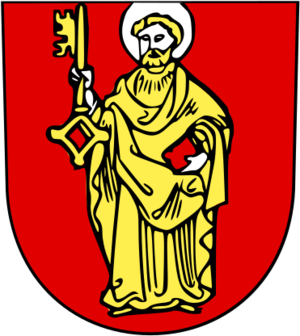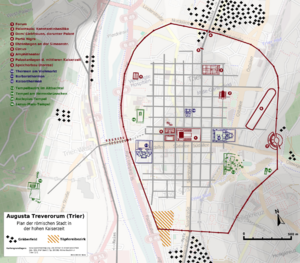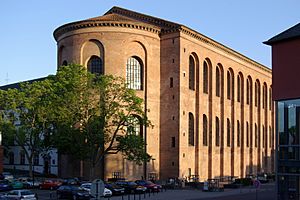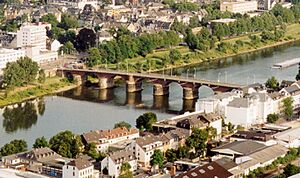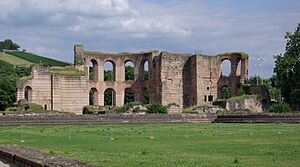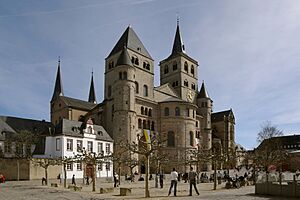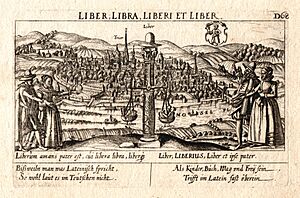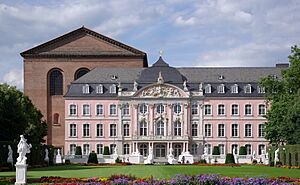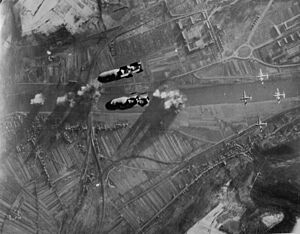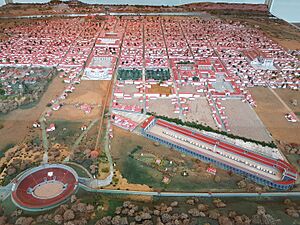History of Trier facts for kids
Trier is a very old city in Germany, located in Rhineland-Palatinate. Its history goes all the way back to the Roman Empire, making it the oldest city in Germany. In the past, people in English often called it Treves, which is its French name.
Contents
Early History
The first signs of people living in the Trier area are from the early Neolithic period, a time when people started farming. This was long before written history! Later, in the centuries before Christianity, a Celtic tribe called the Treveri settled here.
Roman Trier
The Romans, led by Julius Caesar, took control of the Treveri tribe between 58 and 50 BC. Around 16 BC, the Romans founded a city called Augusta Treverorum. This name means "City of Augustus in the land of the Treveri". It's considered the oldest city in Germany. The city was named after Emperor Augustus, a big honor.
Augusta Treverorum became the capital of the Roman province of Gallia Belgica. This was an important step for the city. Around 100 AD, a large amphitheatre was built, which showed how important the city had become. Later, in the second century, a huge Roman circus for chariot races was also built.
Trier's Rise in the Roman Empire
Trier became even more important during a difficult time for the Roman Empire in the 200s AD. From 271 to 274 AD, it was the second capital of the Gallic Empire, a part of the Roman Empire that broke away. Later, from 293 to 395 AD, Trier was one of the main homes for the Western Roman Emperors. This meant many grand buildings were constructed.
A mint (a place where coins are made) was set up in Trier, becoming the most important one in the western Roman Empire. Under Constantine the Great (306–337 AD), the city was rebuilt. Famous buildings like the Palastaula (now known as the Constantine Basilica) and the Imperial Baths were started. These baths are the largest Roman baths still standing outside of Rome!
From 318 AD, Trier was the center of the Gallic prefecture. This was a major Roman government area that controlled western Roman provinces from Morocco to Britain. Important officials called praetorian prefects lived here. Constantine's son, Constantius II, also lived in Trier from 328 to 340 AD.
Trier was the birthplace of Saint Ambrose around 340 AD. He later became a very important bishop in Milan. Another famous person, Athanasius, was also sent to live in Trier by Constantine in 336 AD.
Decline of Roman Trier
From 367 AD, Trier was again an imperial residence under Valentinian I until 375 AD. It was the largest city north of the Alps. However, Roman Trier faced many attacks from Germanic tribes starting around 350 AD. Emperor Julian managed to push them back.
After 407 AD, the Roman Empire struggled to hold onto northern Gaul. Trier was attacked and looted by the Franks four times in the early 400s. The Huns, led by Attila, also attacked Trier in 451 AD. Around 485 AD, Trier officially became part of the Frankish kingdom. Because of all these conflicts, Trier's population dropped from about 80,000 people in the 300s to only 5,000 by the early 500s.
Middle Ages
By the end of the 400s, Trier was under Frankish rule. First, the Merovingian dynasty controlled it, then the Carolingians. In 843 AD, after Charlemagne's empire was divided, Trier became part of the Kingdom of Lorraine. Later, in 870 AD, it joined the East Frankish Empire, which eventually became Germany.
Many abbeys and monasteries were built during the early Frankish period. One important abbey that survived wars is the Benedictine abbey St. Matthias in the south of Trier. This is a very special place because the apostle Saint Matthias is buried there. It's the only tomb of an apostle north of the Alps. This makes Trier, along with Rome and Santiago de Compostela, one of the three main pilgrimage sites in Europe for Catholics.
In 882 AD, the Vikings, also known as the Great Danish Army, attacked Trier and burned most of its churches and abbeys. This marked the end of the grand Roman city of Trier.
Trier's Independence Struggles
A medieval legend says that Trier was founded by Trebeta, the son of a famous king named Ninus, long before Rome was built. An old inscription on a building in Trier says:
- ANTE ROMAM TREVIRIS STETIT ANNIS MILLE TRECENTIS.
- PERSTET ET ÆTERNA PACE FRVATVR. AMEN.
This means: "Thirteen hundred years before Rome, Trier stood / may it stand on and enjoy eternal peace, amen."
From 902 AD, the archbishops gained power over Trier. The Archbishop of Trier became one of the seven Electors of the Holy Roman Empire. This meant they had the right to choose the emperor!
Trier tried many times to become independent from the Archbishop, but it never fully succeeded. In 1212 AD, the city received a special charter from Emperor Otto IV, giving it some rights. However, in 1309 AD, the city had to accept the Archbishop's authority again.
One of the most important Archbishops was Baldwin of Luxembourg, who became Archbishop in 1307 when he was only 22. He was the brother of Emperor Henry VII. Baldwin used his family connections to add a lot of land to the Archbishopric of Trier and built many castles. When he died in 1354, Trier was a thriving city.
The city's dream of self-rule ended for good in 1583. Trier remained the capital of the Archbishopric, but the Prince-Elector (the Archbishop) didn't always live there.
Modern Age
In 1473, the University of Trier was founded in the city. This was an important step for education in the region.
From 1581 to 1593, there were terrible witch hunts in the Trier region. Many people, both rich and poor, were accused and executed.
In the 1600s, the Archbishops and Prince-Electors of Trier moved their homes to a castle near Koblenz.
Wars and Changes
The Thirty Years' War (1618–1648) eventually reached Trier. The city was caught between the Spanish and French forces, and the local archbishop. Trier was occupied by French troops in 1673. They built strong defenses and destroyed buildings outside the city walls for military reasons. However, they were forced to leave in 1675.
In 1684, a new period of French expansion began. Trier was captured again, and this time all its walls and fortresses were destroyed. During the War of Palatinate Succession in 1688, many cities in the area were destroyed by the French army. Even the only bridge over the Moselle in Trier was burned. When the French army left in 1698, Trier was a starving city with no walls and only 2,500 people left.
Trier was occupied by the French again during the War of the Spanish Succession (1702-1714) and the War of the Polish Succession (1734-1737). The last Prince-Elector moved away in 1786. In August 1794, French Republican troops took Trier. This marked the end of the old Archbishopric. Churches and religious buildings were sold or used for other purposes, like stables.
French Rule and Prussian Control
With peace treaties in 1797, German powers gave all German lands on the left bank of the Rhine river to France. Trier became a French city. The University of Trier was closed. In 1798, Trier became the capital of a new French department called Sarre.
In 1801, Napoleon Bonaparte signed an agreement with the Pope, making Trier a diocese again. In 1804, Emperor Napoleon himself visited Trier. During this time, French Trier began to do well.
In 1814, the French era ended when Prussian troops took Trier. After Napoleon's defeat, Trier became part of the Kingdom of Prussia in 1815. This new political situation and new customs borders caused Trier's economy to decline until 1840.
The famous philosopher Karl Marx was born in Trier in 1818. His birthplace, the Karl-Marx-Haus, is now a museum.
Growth and Revolutions
From 1840 onwards, Trier's situation improved. Neighboring Luxembourg, an important market, joined the German Customs Union in 1842. Trier, with about 15,500 people, produced things like leather, cloth, wine, and tobacco. Iron factories were also started nearby.
Transportation improved with paddle-wheel steamers on the Moselle River and the first railway line in 1860, connecting Trier with Saarbrücken and Luxembourg. More railway lines followed, linking Trier to Cologne and Koblenz.
During the revolutions of 1848 in the German states, Trier also saw protests. Citizens demanded more freedoms from the King. When Prussian soldiers clashed with people, the situation became tense. People built barricades and waved red flags. Trier was almost in a civil war until the Prussian army commander threatened to attack the city. The citizens gave up, and some were jailed. Trier became part of the German Empire in 1871.
Second World War
During the Second World War, in September 1944, Trier was very close to the fighting. It was bombed almost every day by American artillery. Later that year, Allied forces carried out three large air attacks on the city.
On December 19, 1944, British bombers dropped many bombs. Two days later, more British and American planes dropped even more bombs, including incendiary and napalm bombs. Another two days after that, 700 tonnes of bombs were dropped.
These attacks killed at least 420 people in Trier. Many buildings were damaged. During the entire war, 1,600 houses in the city were completely destroyed.
On March 2, 1945, the city surrendered to the U.S. 10th Armored Division with little resistance.
After the War
After the war, Trier began to rebuild. In 1969, an old Roman road was found near the Porta Nigra. The University of Trier was reopened in 1970. It became an independent university in 1975.
Other important events in the 1970s included the reopening of the restored Cathedral of Trier in 1974.
In 1984, Trier celebrated its 2,000th anniversary. In 1986, many of Trier's Roman buildings and churches were named a UNESCO World Heritage Site. This includes the amphitheater, Barbara Baths, Imperial Baths, Constantine Basilica, Porta Nigra, Roman bridge, Dom St. Peter, and Liebfrauenkirche.
In 1993, a huge collection of 2,558 Roman gold coins was found during excavation work. These coins are worth a lot of money!
In 2007, a large exhibition about the Roman Emperor Constantine the Great was held in Trier. It was one of the most successful exhibitions in Germany, attracting many visitors.
In July 2021, the Ehrang/Quint district of Trier was badly damaged by floods.
City Growth
Over time, several smaller towns and areas have become part of the city of Trier. This helped the city grow. For example, in 1888, St. Paulin and other areas joined Trier. Later, in 1969, Ehrang-Pfalzel and other municipalities were incorporated, making Trier much larger.
Population Changes
At its peak in the 300s AD, Trier was the home of the Roman Emperor and had about 80,000 people, making it the largest city north of the Alps. However, wars, diseases, and famines in the Middle Ages caused the population to drop to only 2,677 by 1697.
The population started to grow again in the 1700s, reaching 8,829 in 1801. The start of factories and industries in the 1800s made it grow even faster. By 1900, over 43,000 people lived in Trier, and by 1939, this number had doubled to over 88,000.
The Second World War caused Trier to lose about 35% of its people. The population dropped to 57,000 by 1945. Only when several surrounding areas became part of the city in 1969 did the population reach its pre-war level again. This growth pushed the number of people in Trier past 100,000, giving it the status of a "Großstadt" (large city).
Here's a look at how Trier's population has changed over the years:
|
|
|
¹ Census figure


